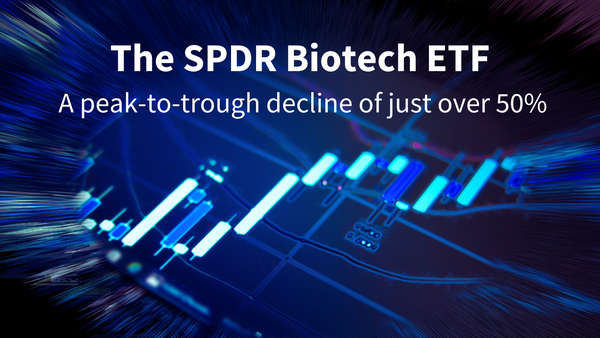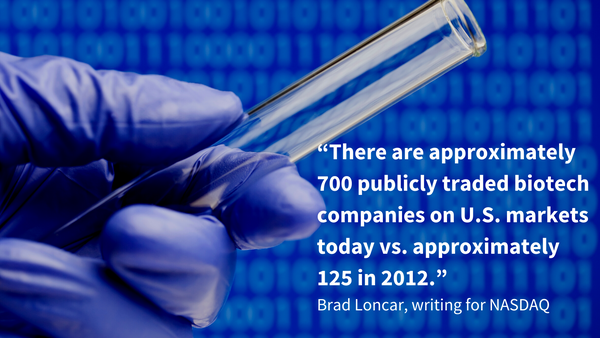Wall Street biopharma investment bank equity research analysts, colloquially called sell-side analysts, are an interesting bunch. For all intents and purposes, the main qualification for the job is that you are always bullish. In fact, the preverbal sell-side euphemism for when a biopharma company releases bad news is called a clearing event.
As in, “Whew, we got that out of the way, now we can invest!”
Biopharma, as a whole, has had a lot of clearing events over the past twelve months!
The SPDR Biotech ETF (XBI), traditionally used to benchmark the performance of the small to mid-cap biopharma industry, peaked at $175 per share in early February 2021. Last week, it hit $85 per share, a peak-to-trough decline of just over 50%. It has been a real punch in the gut for biopharma investors, especially in light of the broader market, as represented by the S&P-500 and Dow Jone Industrial Average (DOW) exiting 2021 at all-time highs.
The rout in biopharma over the past year is a stark and somewhat shocking turnaround for investors. After many years of out-performance, biopharma was among the worst-performing industries in 2021. Sure, the second half of 2015 was a disaster, courtesy of Hillary Clinton’s tough talk on drug pricing and infamous tweet directed at Martin Shkreli, but it was one heck of run from the COVID-induced panic lows in early 2020.
It’s Never That Easy
In fact, the surge from $65 in March 2020 to $175 over the next 11 months was among the strongest moves in the history of the (XBI) index. No doubt, these returns were driven by positive news on the developments of therapeutics and vaccines for COVID from companies like Pfizer, Moderna, and Gilead at a time when most other sectors were struggling to find customers. In 2020, biopharma was a safe haven, and the massive moves higher in some vaccine names like Moderna and Novavax drew a lot of speculative investors in the sector. Moderna (MRNA) went from $30 per share to nearly $500 per share in 18 months. The false perception was that it was easy, or this was normal.
One of the benefactors to this misconception was an aggressive biopharma-focused ETF, the ARK Genomic Revolution Fund (ARKG). ARKG saw its fund NAV go from $25 per share in March 2020 to nearly $110 per share by early February 2021. Assets under management (AUM) soared from $2.5 billion to $12.5 billion, with over half of that gain from new asset inflows. Investors were buying biotech hand-over-fist.
But it’s never that easy, and what was a massive COVID-fuels tailwind for the healthcare sector in 2020 became a massive headwind in 2021. A small handful of vaccines makers benefited, but outside this group, commercial biopharma stories struggled, challenged by the difficult environment to promote new drugs and many hospitals putting elective surgical procedures on hold as the pandemic surged and resurged.
Healthcare Funds Shift Focus
The challenging commercial environment and squeezing-out effect by a few behemoth drug makers caused a shift in strategy for many healthcare-focused hedge funds. Some of these funds have become so large that they can no longer generate outsized returns from investing in small public companies. What was once a needle-moving bet on a $250 million biopharma company now becomes prohibitively impossible to reproduce thanks to the law of large numbers - funds like RA Capital and Orbimed are simply too big to get size in small-cap stocks. So they moved to invest in private companies and became crossover funds.
And they had a fantastic year!
According to Crunchbase, RA Cap. was the lead investor in over 25 venture-backed start-ups in 2021, participating in over 60 total. By all accounts, 2021 was the year of the biopharma IPO; over 100 took place. That’s up from 71 in 2020 and historically 40-50 in the prior years. The 2021 biotech IPO boom brought many companies public at valuations inflated by crossover funds and newly formed SPACs.
Yet, according to Barron’s, the vast majority of these names are now trading well below their offering prices. These names were sold to the public as great investments, with cutting-edge science and revolutionary technology - albeit based on preclinical data generated from animals or in a test tube. Numerous biopharma companies carried valuations in excess of a billion dollars without generating a single data point in human patients.
It’s reminiscent of the financial crisis over a decade ago where Wall Street investment banks packaged up low-quality mortgages and sold them to unsuspecting investors as secure investments. The truth is, many of these names should never have come public, especially not with such lofty valuations. The lesson is, never underestimate the ability of investment banks and hedge funds to dupe the average investor into buying their ideas. Exuberance happens at the top of the market.
Too Many Cooks
Despite the fact that we are finally starting to see some push-back on the SPAC craze and the biopharma IPO market has cooled in the fourth quarter of 2021, much of the damage has been done. Evercore analyst, Josh Schimmer, noted there are just too many public biotech companies to keep track of now. Industry veteran, Brad Loncar, writing for NASDAQ, noted, “There are approximately 700 publicly traded biotech companies on U.S. markets today vs. approximately 125 in 2012.”
“There’s a lot of sludge to dig through,” said one independent analyst. “You would pick disease and know the major players… maybe have to analyze four or five drugs to understand the dynamics. Now, there are 40 players. You can make a bet and think you’ve got it all figured out, only to be surpassed a month later by a new company you never heard of.”
The sheer number of players makes due diligence difficult, especially for small family offices or individual investors. TD Ameritrade coined the term “analysis paralysis”. This might be one reason we saw biopharma M&A slow in 2021 despite hefty cash balances and favorable valuations. The business development departments at big pharma are probably having the same problems that individual investors are having.
There are too many biotech companies developing too many drugs with an incrementally only marginal benefit over existing drugs, and not enough patients to take those drugs and create attractive commercial opportunities. Orphan diseases are an orphan disease for a reason. What was once a niche area of the market has turned into a crowded strategy.
There’s also the fear of getting leapfrogged by new technology. Things like cell therapy, CRISPR, mRNA vaccines, and DNA base-editing are all paradigm shifts in healthcare drug development. Individual investors and business development departments must be cognitively aware that, at any time, what looks like a great drug can become obsolete quickly.
And Then, There’s This
The above challenges alone are enough of a headwind on the biopharma industry that it’s not hard to understand why the market took a downturn in 2021. But there’s more still for investors to worry about. Back in August 2021, notably ahead of what was a horrid second half of the year for the SPDR Biotech Index (XBI), President Biden called on Congress to enact sweeping legislation to lower prescription drug prices. The key points of the proposal not only call for the ability of Medicare to negotiate lower prices on prescription drugs, but it also calls for potentially reducing the exclusivity period on new drugs, specifically small molecules, allowing for earlier than previously allowed generic competition.
This name came only a month after the President lifted the ban on march-in-rights in July 2021. March-in rights were introduced in 1980 to promote access to generic drugs. It gives the federal government authority to force public and private pharma companies to license drug patents to third-party manufacturers should the patent-holders receive public funding. President Trump banned the law in 2020 to encourage the development of COVID vaccines. Biden’s reversal, along with tough talk a month later on pricing, fired the first warning shots at the sector.
This is not the first-time lowering prescription drug prices has been a headline issue (note the aforementioned infamous Hillary Clinton Tweet in 2015), but Biden’s comments, along with previous comments from his administration about potentially waiving patents on COVID vaccines, really seemed to spook the market last year.
Prescription drugs account for only 14% of healthcare spending in the U.S., but pharmaceutical drug development is incredibly expensive, and the fear is that margin pressure potentially limits innovation in the years to come. Innovation costs money, and less of it flowing to the bottom line is bad news for small and mid-cap names where innovation is the business model.
Another systemic headwind is the rising inflation seen in the second half of 2021 and the potential that the U.S. Federal Reserve raises interest rates too high, slowing the already fragile recovery just as we emerge from the COVID pandemic.
The biopharma industry is heavily capital-dependent. Investors require higher rates of return to account for the risk of drug failures. As interest rates rise, capital becomes more expensive and investors’ appetite for risk curtails. That’s the fear, although history suggests the performance of the biotech industry is not highly correlated with interest rates, it is highly correlated with the performance of the overall economy. The already fragile, high beta, biopharma sector is at the mercy of the overall trajectory of the economy in 2022.
Don’t Throw in The Towel Just Yet
The biopharma industry faces a lot of challenges and headwinds in 2022; but there are also reasons to be optimistic. Big pharmaceutical companies are loaded with cash, buoyed by sales of COVID vaccines and lower-than-normal M&A in 2021. The thought is that these industry bellwethers will spend some of that war chest in 2022. Yes, business development offers will have to sift through a lot of names, but valuations are certainly more attractive now than a year ago and several big pharma companies have recently expanded their cash position by selling or spinning-off assets. Additionally, a return to normalized IPO levels is probably a good thing long-term.
Finally, the science has never been more exciting. Innovations in genomic editing, cell therapy, and the use of AI and computer (in silico) modeling to discover new drugs hold tremendous promise. Gene and cell therapies are moving from clinical to commercial and researchers are making breakthroughs in areas of oncology and rare diseases at extraordinary paces. A little good news could go a long way to restoring confidence in the sector because, after the last few months, it’s hard to imagine it getting worse!
Content Carnivores is dedicated to delivering the highest standards of ideas and writing so that greatness finds its widest audience to deliver on business objectives. Headquartered in Chicago, they leverage a proprietary technology platform that dramatically speeds up the discovery, creation, and publication of high-quality content to help brands and businesses amplify awareness and establish thought leadership to their target audiences.
The company founders built the technology and ran content marketing programs for Monster, Coca-Cola, and other content marketing pioneers. Current customers include leaders in healthcare, marketing, medical devices, financial services, and technology.






